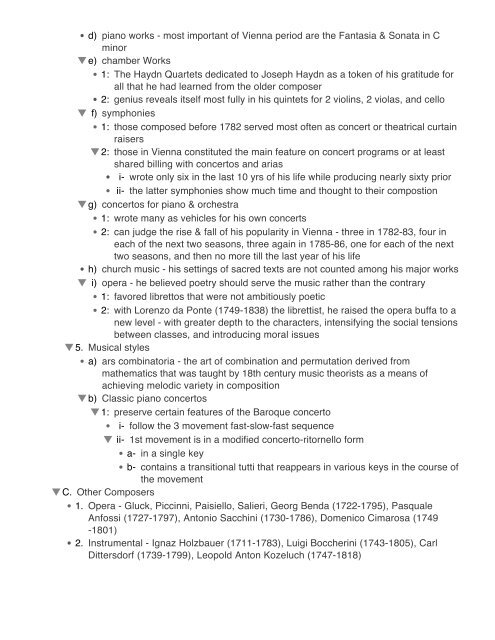An Outline of The History of Western Music Grout ... - The Reel Score
An Outline of The History of Western Music Grout ... - The Reel Score
An Outline of The History of Western Music Grout ... - The Reel Score
You also want an ePaper? Increase the reach of your titles
YUMPU automatically turns print PDFs into web optimized ePapers that Google loves.
d) piano works - most important <strong>of</strong> Vienna period are the Fantasia & Sonata in C<br />
minor<br />
e) chamber Works<br />
1: <strong>The</strong> Haydn Quartets dedicated to Joseph Haydn as a token <strong>of</strong> his gratitude for<br />
all that he had learned from the older composer<br />
2: genius reveals itself most fully in his quintets for 2 violins, 2 violas, and cello<br />
f) symphonies<br />
1: those composed before 1782 served most <strong>of</strong>ten as concert or theatrical curtain<br />
raisers<br />
2: those in Vienna constituted the main feature on concert programs or at least<br />
shared billing with concertos and arias<br />
i- wrote only six in the last 10 yrs <strong>of</strong> his life while producing nearly sixty prior<br />
ii- the latter symphonies show much time and thought to their compostion<br />
g) concertos for piano & orchestra<br />
1: wrote many as vehicles for his own concerts<br />
2: can judge the rise & fall <strong>of</strong> his popularity in Vienna - three in 1782-83, four in<br />
each <strong>of</strong> the next two seasons, three again in 1785-86, one for each <strong>of</strong> the next<br />
two seasons, and then no more till the last year <strong>of</strong> his life<br />
h) church music - his settings <strong>of</strong> sacred texts are not counted among his major works<br />
i) opera - he believed poetry should serve the music rather than the contrary<br />
1: favored librettos that were not ambitiously poetic<br />
2: with Lorenzo da Ponte (1749-1838) the librettist, he raised the opera buffa to a<br />
new level - with greater depth to the characters, intensifying the social tensions<br />
between classes, and introducing moral issues<br />
5. <strong>Music</strong>al styles<br />
a) ars combinatoria - the art <strong>of</strong> combination and permutation derived from<br />
mathematics that was taught by 18th century music theorists as a means <strong>of</strong><br />
achieving melodic variety in composition<br />
b) Classic piano concertos<br />
1: preserve certain features <strong>of</strong> the Baroque concerto<br />
i- follow the 3 movement fast-slow-fast sequence<br />
ii- 1st movement is in a modified concerto-ritornello form<br />
a- in a single key<br />
b- contains a transitional tutti that reappears in various keys in the course <strong>of</strong><br />
the movement<br />
C. Other Composers<br />
1. Opera - Gluck, Piccinni, Paisiello, Salieri, Georg Benda (1722-1795), Pasquale<br />
<strong>An</strong>fossi (1727-1797), <strong>An</strong>tonio Sacchini (1730-1786), Domenico Cimarosa (1749<br />
-1801)<br />
2. Instrumental - Ignaz Holzbauer (1711-1783), Luigi Boccherini (1743-1805), Carl<br />
Dittersdorf (1739-1799), Leopold <strong>An</strong>ton Kozeluch (1747-1818)





